Glass aprons for the kitchen: varieties, tips for choosing and care
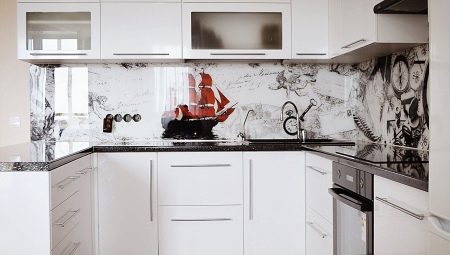
Glass is considered an excellent alternative to traditional ceramic tiles, as well as plastic panels and some other materials that are most often used to decorate a kitchen backsplash - a small section of a wall near a work area. It is environmentally friendly and one of the most hygienic materials. It is known that glass is not afraid of steam, water, it does not absorb dirt and grease, it is quickly cleaned, it looks very impressive and stylish.
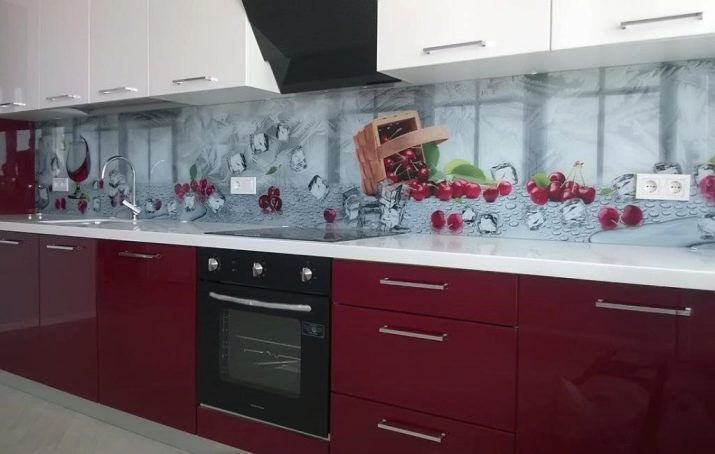
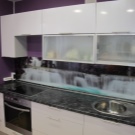
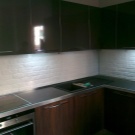
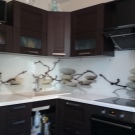
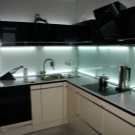
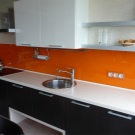
Peculiarities
A kitchen apron is a must-have for any modern kitchen. This is a low part of the work surface, designed to protect the wall from dirt, which is inevitable when cooking. The panels are available in a wide variety of designs and shades. In previous years, aprons were more and more laid out of tiles, but nowadays they often prefer such a modern material as glass.
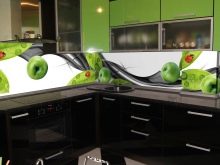

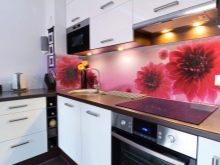
Many housewives refuse to install a glass apron on the base, which is better than any other material, showing splashes of water, handprints and grease stains. This is one of the common misconceptions because in fact, there is no more contamination on such an apron than on any other coating.
At the same time, it is much easier to take care of it, since there are no inter-tile joints in such surfaces, where dirt can accumulate.
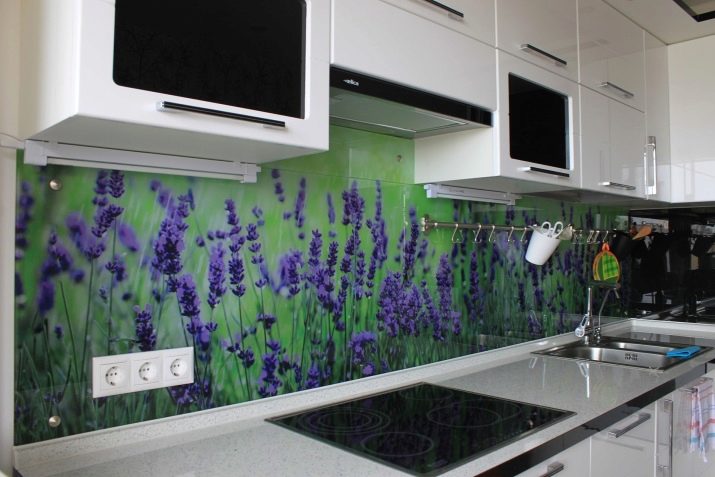
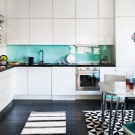

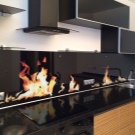
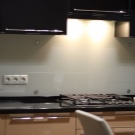
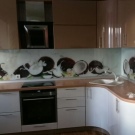
Of course, for the manufacture of a protective apron, it is not the usual one that is used, but specially tempered glass with a thickness of 4-8 cm - only in this case it will provide full protection and will last for several years and even decades.
Besides being tempered glass and much safer - it will not break and will not go with numerous cracks under light mechanical stress. Aprons made of this material are not afraid of proximity to the stove, since they are not affected by high temperatures in any way. Simple glass is devoid of all these qualities, and therefore the time of its operation is much shorter.
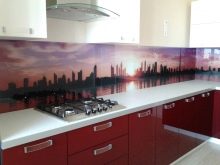
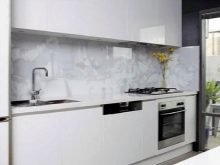
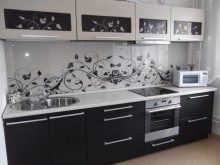
Advantages and disadvantages
Let's dwell on the advantages of glass aprons.
- Glass coatings do not require specialized maintenance. The material does not absorb grease, water, dust and coloring pigments, therefore the apron retains its aesthetic appearance for a long time. All that is needed from the hostess is to wipe the surface with a damp cloth from time to time.
- Glass coatings are particularly hygienic. The fact is that the material has a rather dense structure, so fungi do not multiply on it, mold and other pathogenic microflora do not appear.
- Glass aprons look very stylish, they visually expand the space, make it lighter... In addition, on sale you can find glass of a wide variety of colors and textures, there are models decorated with painting, photo printing, supplemented with backlighting and other original options. Thanks to this choice, everyone will be able to arrange an apron to their taste and wallet.
- Tempered glass is very durable, it can be used for many yearswithout losing its original gloss.
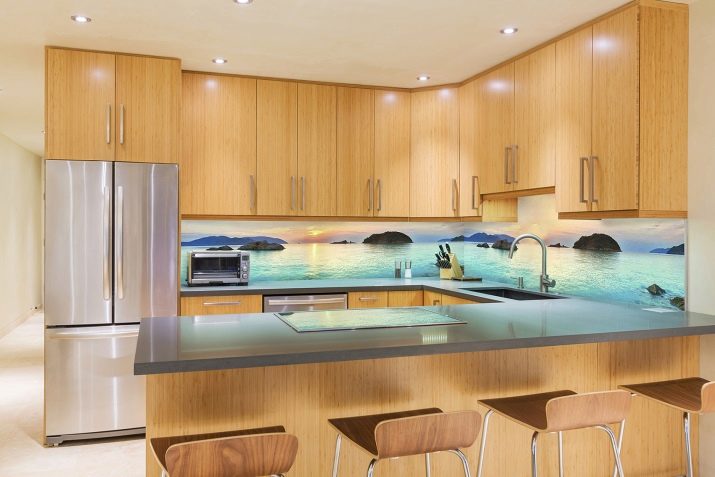
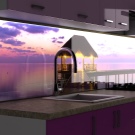
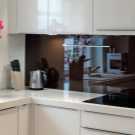
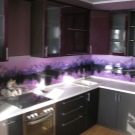
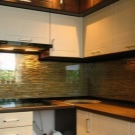
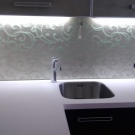
This material has few drawbacks.
- You cannot cut the finished panel into parts and in any other way adjust its parameters for fastenings, you cannot drill additional holes in it, so you need to think over all the details of the panel placement in advance.
- The glass panel is quite expensive; not every our compatriot can afford such aprons. Of course, a long service life will fully pay off all investments, but in any case, the initial amount is too much for many.
- Glass aprons are not suitable for all styles, for example, they are unlikely to look harmonious in interiors furnished in shabby chic, Provence or country decors.
- When installing a glass panel, special skills are required for carrying out such work; you are unlikely to be able to cope on your own.
- Glass panels usually do not belong to "eternal" materials, although they serve for a long time, but still manufacturers usually give a guarantee for their aprons.
- There are myths about the excessive fragility of this material, but they are all spread by people who approached the issue of installing an apron without the necessary preparation or selected material that was absolutely unsuitable for this purpose.

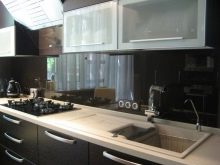
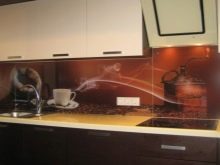
Varieties of materials
Several types of materials are used for the production of glass aprons.
- Stalinite - it is popularly called heat-resistant "tempered glass". The material fully meets all the requirements for aprons. The heat resistance of tempered glass is 8-9 times higher than that of ordinary glass. It is quite difficult to break the Stalinite - if this happens, then the fragments will be rather small and blunt so that a person cannot get hurt about them.
Stalinite surfaces can even be installed above the stove, since no heat is dangerous to it, and even the cheapest abrasive cleaning pastes can be used to clean the surface, since it cannot be scratched.
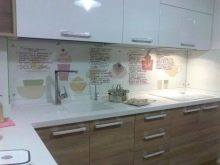
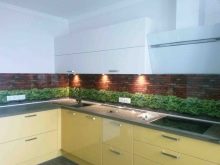
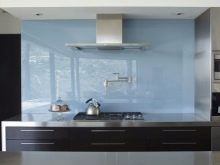
- Triplex - refractory material, consisting of several layers, at least 2. Usually, tempered or silicate glass is taken as a basis, during the production process a polymer layer is formed between them, due to which gluing occurs.
The result of using this technology is increased strength and increased reliability of the material, even with strong mechanical stress, the apron will not disintegrate into small fragments, but will only crack.
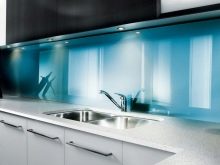
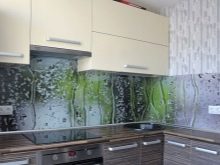
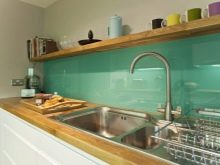
- Plexiglass - it is a plastic material made of acrylic. It is distinguished by its strength and ease of installation. Nevertheless, there are limitations in the application of the coating - for example, plexiglass is not allowed to be hung over the hob, since this material can withstand temperatures only up to 75-85 degrees, at higher temperature influences its deformation begins.
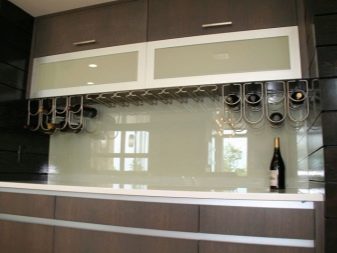
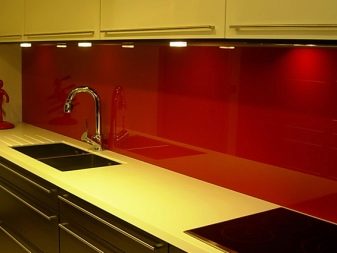
- Polycarbonate Is a material with an optimal price / quality ratio. With exceptional operational characteristics of the composition, polycarbonate is affordable. An apron made of it will be durable, since the material cannot be broken even with a sledgehammer. At the same time, it is distinguished by flexibility and elasticity, and therefore installation does not require serious efforts. At the same time, polycarbonate is quite sensitive to temperature fluctuations, it is easy to scratch, and over time it sometimes bursts, noticeably fades and acquires noticeable yellow tints.
To avoid such consequences, usually polycarbonate is pasted over with a special film - it not only increases resistance to scratches, but also protects against the negative effects of ultraviolet radiation.
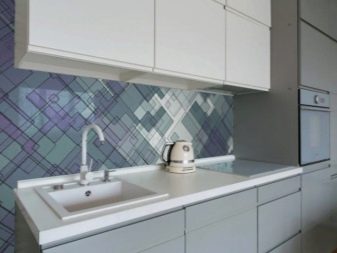

- Mirror - such an apron looks invariably stylish, impressive and unusual. Such a solution will visually increase the space, improve the illumination of the working area and the entire kitchen in general.
However, not every housewife is comfortable observing herself from the side while cooking or cleaning, therefore, instead of a mirror, mirror tiles with light matting or sandblasting are most often used.
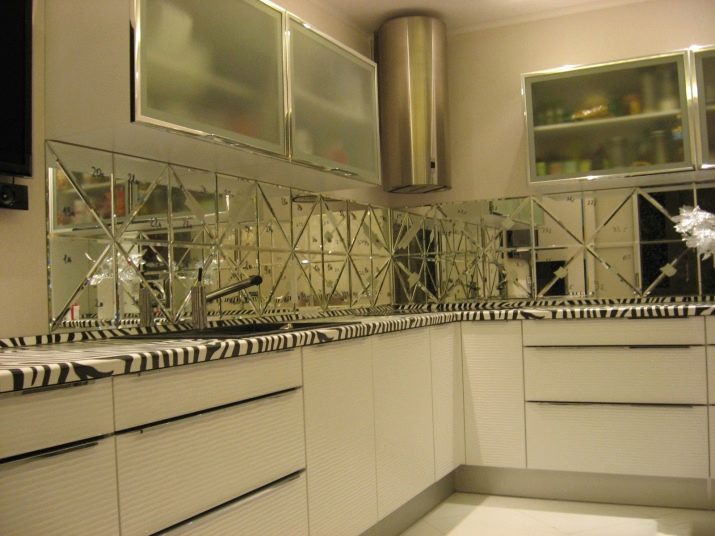
Color spectrum
In terms of color, the glass used to create aprons ranges from the simplest monochrome translucent tones (beige, black, white) to rainbow (blue, green, red) and shimmery tones. On request, you can make glass tiles with the finest gold veins or buy a panel decorated with a unique painting - such solutions will allow you to create non-trivial and stylish design accents in the interior of the kitchen.
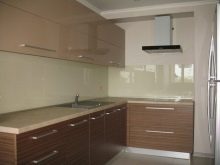

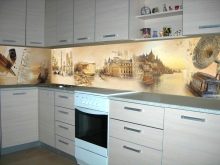
The most affordable apron option is use of colorless glass with a high degree of transparency. This material is optimal if you do not have the need and desire to mask the texture of the wall, since such aprons do not hide anything at all. In most cases, such a panel is placed on a surface finished with decorative plaster, wallpaper, or red brickwork.
This invisible apron seems to dissolve in the air, its only task is to protect the wall from drops of water, grease and other contaminants.
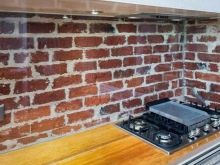
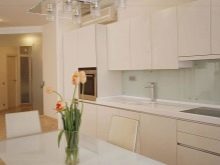
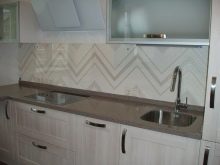
Colorless glass can be made in matte finish - this way it looks much more impressive and gives much less bright glare. By the way, it is not at all necessary that the glass cover should be smooth, for example, a panel with a satin-finished surface always looks stylish and elegant. Monotonous colored glass looks very bright, but at the same time laconic, while the range of possible colors, without exaggeration, is large.
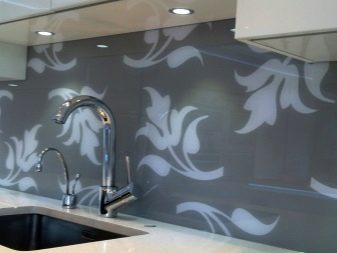
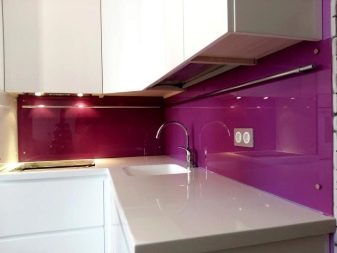
There are several interesting options for the multi-colored design of the apron in the kitchen for a glass surface, as a rule, for this, the following modifications are applied.
- Stemalit, which is painted for a start, and then subjected to heat treatment in order to give the applied coating a special durability, to make the apron more durable.
- Satin - this material is tempered frosted glass, most often it is decorated with sandblasted ornaments.
- Activate - another type of colored thermal glass, as a rule, it undergoes additional bleaching to give the required color.
- Triplex - laminated glass, the desired shade of which is given by inserting a colored film between the layers.
- A more economical option would be an apron with a thin vinyl film, it is on it that the pattern is applied. Usually it is rolled onto the back of the glass, it will protect the picture from the action of water, heat, steam and dirt. At the same time, such an option often turns out to be short-lived - the film wrinkles and peels off, and burns out under the influence of ultraviolet radiation.
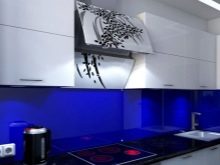
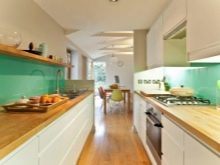
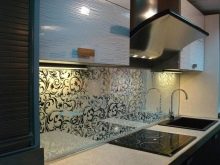
In order to make glass aprons more stylish, various ways of decorating are possible. Photo printing has become one of the most common options - plates with a stylish pattern applied to them are called skinals, today this design is considered the most common. UV printed kitchen aprons are usually durable and aesthetically pleasing.
Usually the picture is applied to the back of the glass using special ink. Such patterns do not fade under the influence of sunlight, they are not afraid of water, and at the same time, without prejudice to their appearance, they withstand heat up to 110-130 degrees.
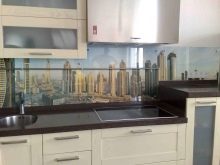
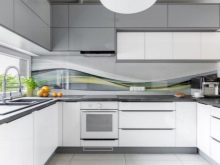
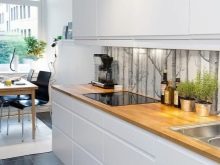
Looks very stylish panels with 3D effect, but such an apron will cost the owners of the kitchen much more expensive than colorless or monochrome colored glass. Most often, for decorating a glass product, they turn to landscapes, frescoes or pictures with a view of a metropolis.
They add space to the room and seem to push the boundaries, so such options are optimal for a small kitchen.
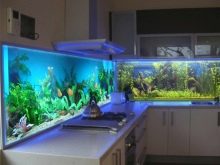
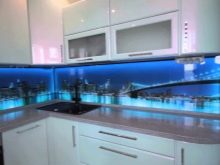
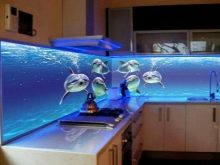
When arranging the interior in a modern style, backlit plates are most often used. Such a solution looks original and invariably expensive. Without a doubt, such an apron has every chance of becoming a leading decorative element of the kitchen interior. Usually, the LED strip is attached along the perimeter of the canvas or on the inside, most often colorless options are used, but the use of other multi-colored light sources is also allowed.
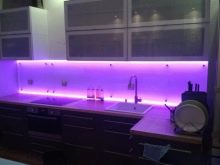
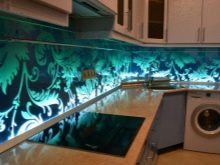
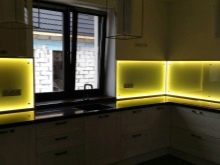
Mosaic glass tiles look very impressive - these are glass panels of small dimensions. Depending on the manufacturer, shapes and patterns may vary. In previous years, production was limited to quadrangular models, but today hexagonal structures are gaining more and more popularity. At the same time, there are glass tiles imitating a stone, as well as stained glass mosaic.
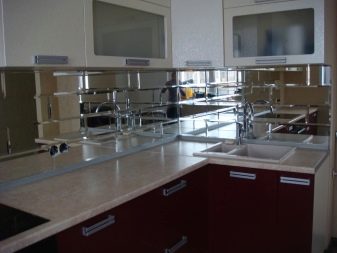
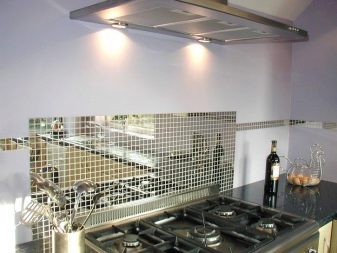
Style solution
Due to the wide variety and wide range of options for decorating a glass kitchen apron, it can be used for the most varied stylistic interior design - from classic to minimalism. However, each case has its own subtleties of use.
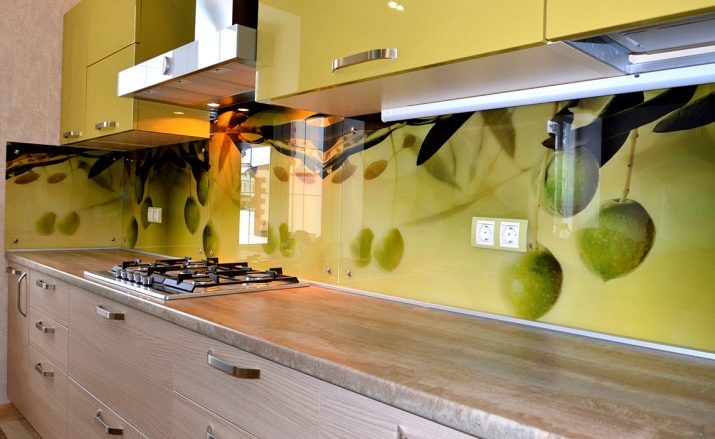
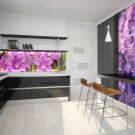
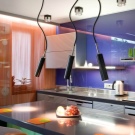
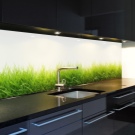
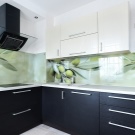

Perhaps the best combination would be glass and hi-tech, at the same time, in the arrangement of the interior, you can use a wide variety of types of glass surfaces - colorless, monochrome, with photo printing, flower patterns.
The only limitation is that the glass must be glossy, matte motives have no place in an ultramodern kitchen. Designers recommend applying a drawing on the reverse side, corresponding to the general theme of the interior. For example, the image of a night city looks stylish, as well as complex geometric prints, reproductions of works by impressionist artists will be a good solution.
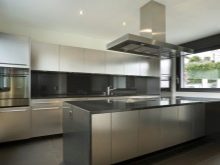
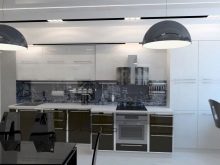

Minimalism also looks harmoniously in tandem with glass elements, in this case it is better to give preference to completely transparent models that will demonstrate the surface of the wall. Alternatively, you can paint the glass with paint in a color that is in harmony with the overall tint design of the interior.
Prints and photo printing are allowed, but without them the room will look more conceptual.
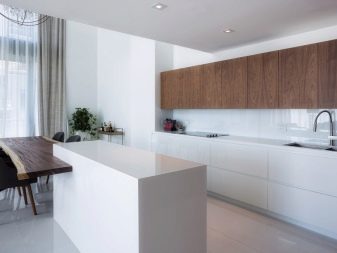

Usually glass is not combined with classics, but still its use is allowed. In this case, it is best to use frosted surfaces; it will not be superfluous to supplement them with drawings - for example, images of famous paintings or delicate floral patterns.
It is very important that the panel fits into the chosen style as harmoniously as possible and does not enter into dissonance with it. Glossy surfaces, as well as mirrors in classic interiors will be inappropriate, so they can be safely discarded.
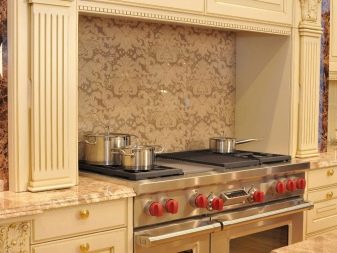
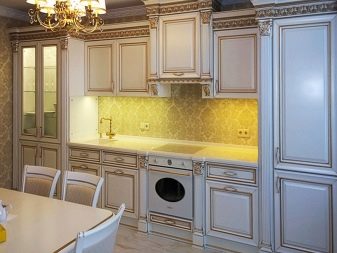
Ethnic style involves the use of a wide variety of designs, but in this case it should be clearly traced national solution concept... So, for a kitchen in Japanese decor, beautiful aprons with orchids are suitable, but for scandi, landscapes of snow-capped mountains or summer forest glades will be the best solution.
If you prefer industrial, you should give preference to a frosted glass apron, as this style is not characterized by an excess of detail. Loft-style kitchen design involves the use of transparent panels that do not hide brickwork or natural wood in the wall design.
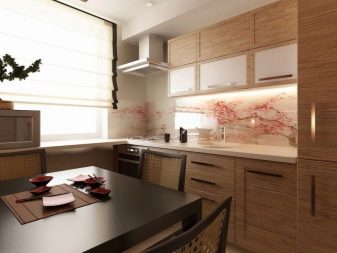
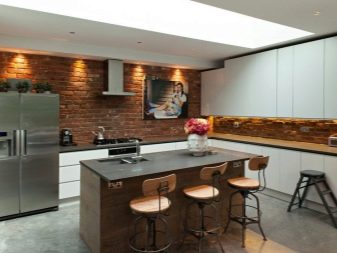
When choosing a skin, it is imperative to take into account the color scheme of the kitchen interior. For example, if the room is replete with bright, eye-catching details, for example, in the Baroque style, then it is best to use transparent or plain aprons. Laconic models will also be the optimal solution for rooms in which the kitchen set is decorated with painting.
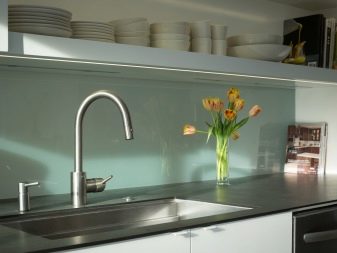

How to choose?
In order for a glass kitchen apron to serve you as long as possible and not lose its decorative and operational characteristics over time, you should carefully approach the choice of material. Experts recommend using several rules.
- It is better to stop the choice on tempered glass - it is characterized by increased strength, and even if it has to be hit by a heavy cast-iron frying pan, the surface will still survive.
- When choosing a material, it is advisable to proceed from the general style of the kitchen interior - the apron must certainly be in harmony with it and emphasize the attractiveness of the design.
- If you plan to mount an apron near the hob, give preference to plexiglass and other materials that can withstand increased temperature influences.
- If the kitchen faces the sunny side, then abandon the idea of using polycarbonate. The fact is that under the influence of ultraviolet radiation, it turns yellow.
- Before making a purchase, be sure to make all the necessary measurements so that the canvas fits perfectly into the size of your future apron. If you do not have experience in such work, it is better to contact professional measurers.
- Great attention should be paid to the glass thickness parameter. This value largely depends on the size of the apron itself - for example, for skins with a length of 1 meter, a thickness of 4-5 mm will be optimal, if skins are longer, then glass is needed from 6 or more mm.

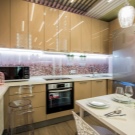
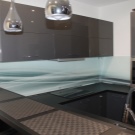
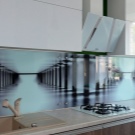
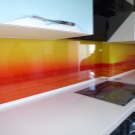
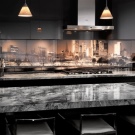
Please note that size limitation applies for skins. In accordance with the standards, the maximum parameters of length and width can be no more than 3300x1200 mm. If the working area has other parameters and a more elongated apron is needed, then several panels will have to be made.
Usually they resort to options with identical decor or scattered pictures that merge into a single visual concept.
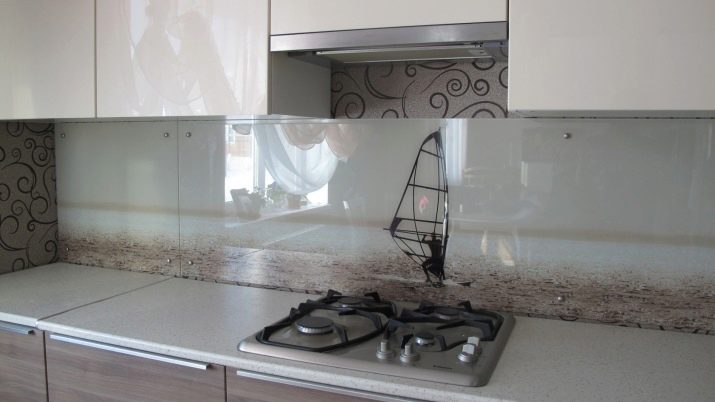
How to care?
As we mentioned at the very beginning - glass kitchen aprons are easy to clean. In order to keep the stoves clean, no special trouble is required from the hostess. To maintain hygiene, the most common detergents that are sold in every supermarket are enough. They are usually sprayed onto the surface of a kitchen backsplash and then wiped with a soft dry cloth.
Such manipulations are repeated as necessary in the event of contamination of the panels.As a rule, there are no seams in glass aprons or they are almost invisible, so dirt does not accumulate in them - accordingly, the leaving process does not take much time.
When using mirrored surfaces, it is better to clean it daily - the smallest stains are clearly visible on such materials.
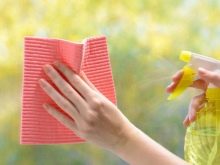
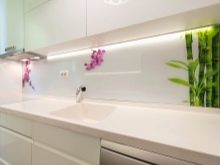
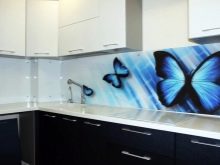
Beautiful examples
Glass is an excellent material that can successfully replace many of the most expensive panels. It is not only not inferior to more modern coatings in terms of technical and operational characteristics, but often surpasses them. And the variety of decors will always allow you to choose an option that will harmoniously fit into any interiors.
- In loft-style kitchen interiors, it is better to give preference to transparent glass aprons.
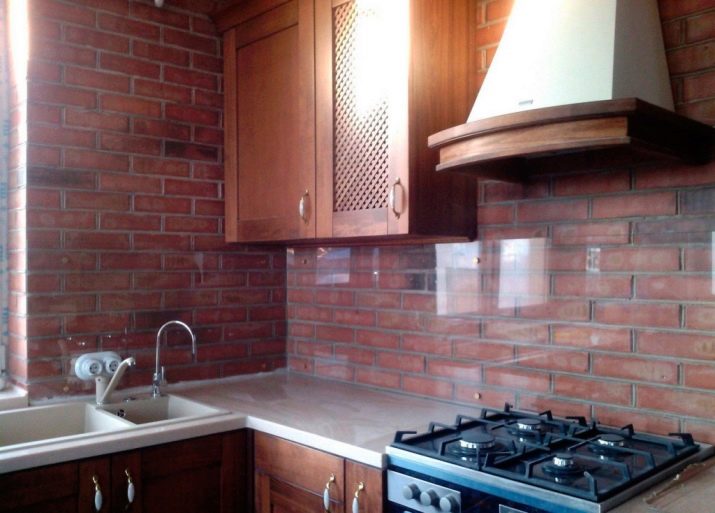
- White surfaces go well with the classic style.
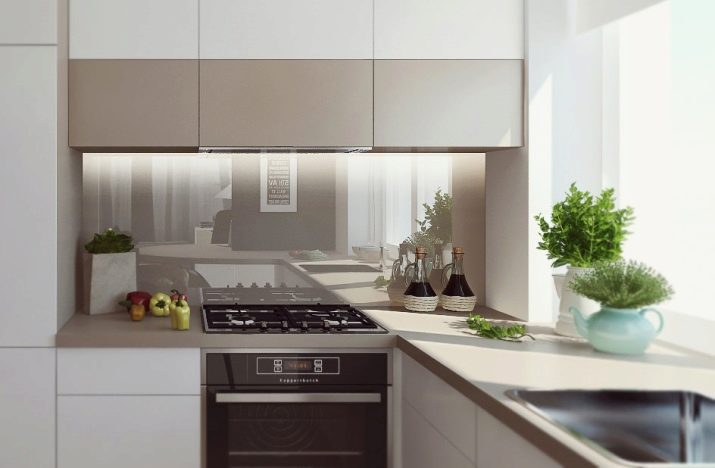
- Multi-colored aprons look very impressive, they set stylish accents in the room and emphasize the thoughtfulness of the design.
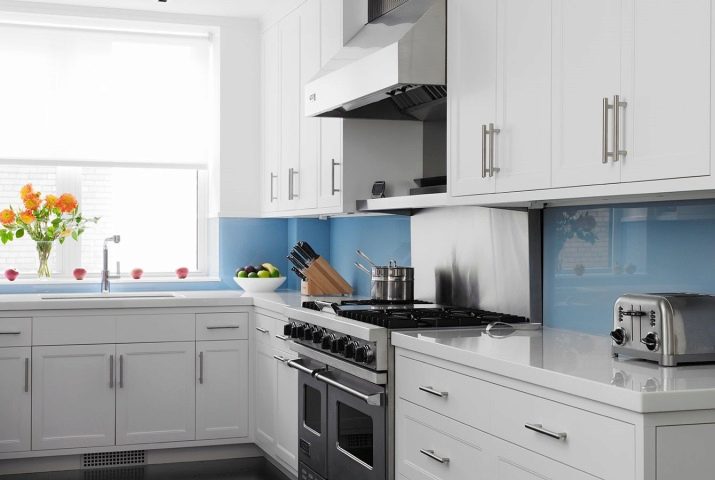
- The most unusual effect can be achieved when using aprons with patterns.
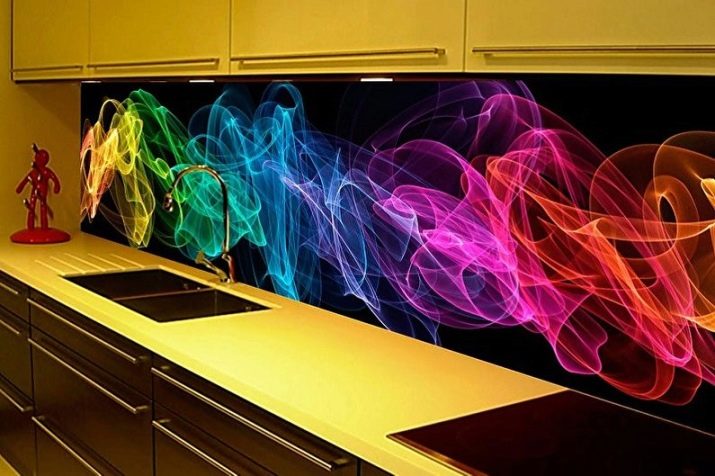
For the pros and cons of a glass apron, see the next video.








